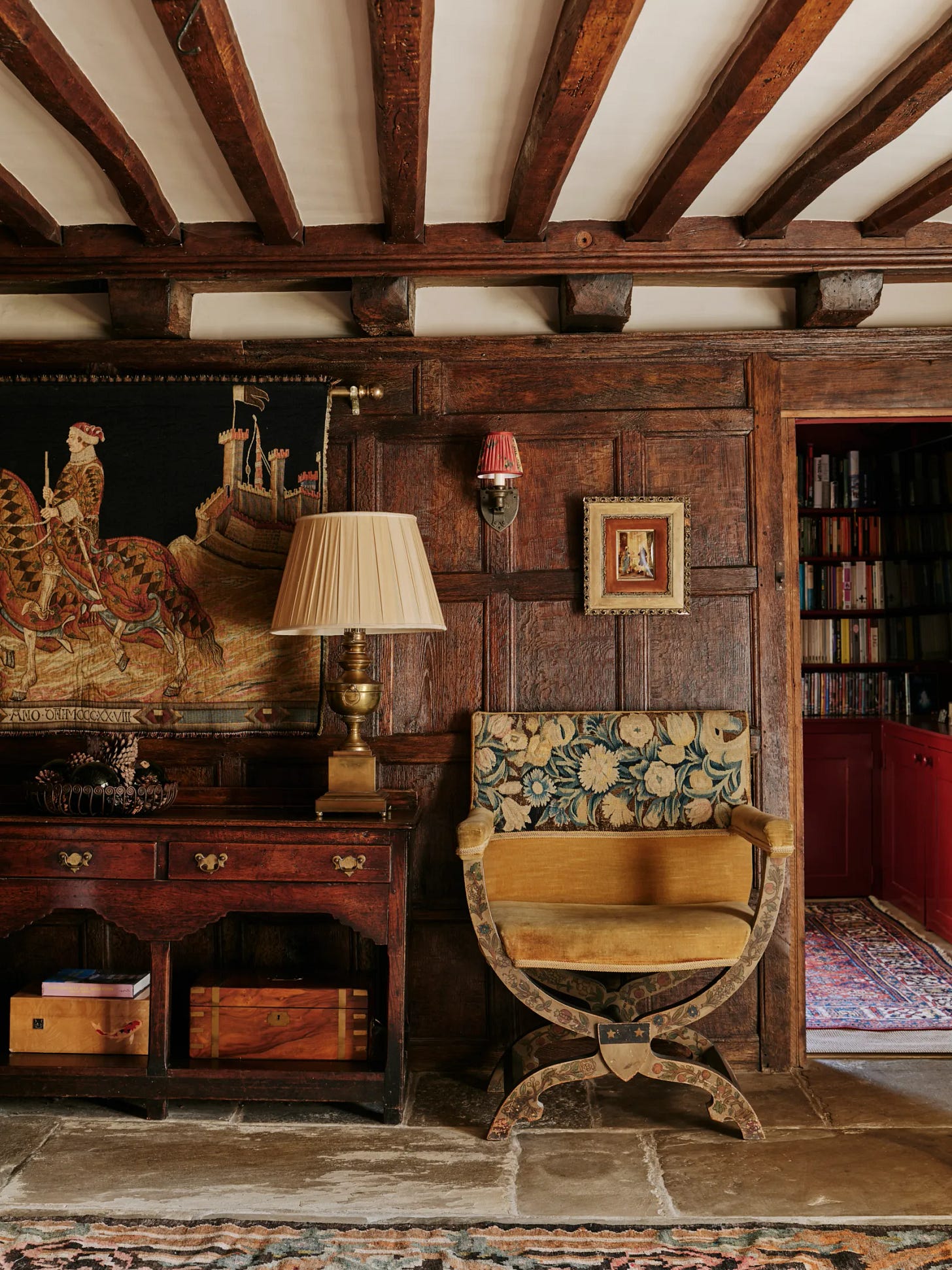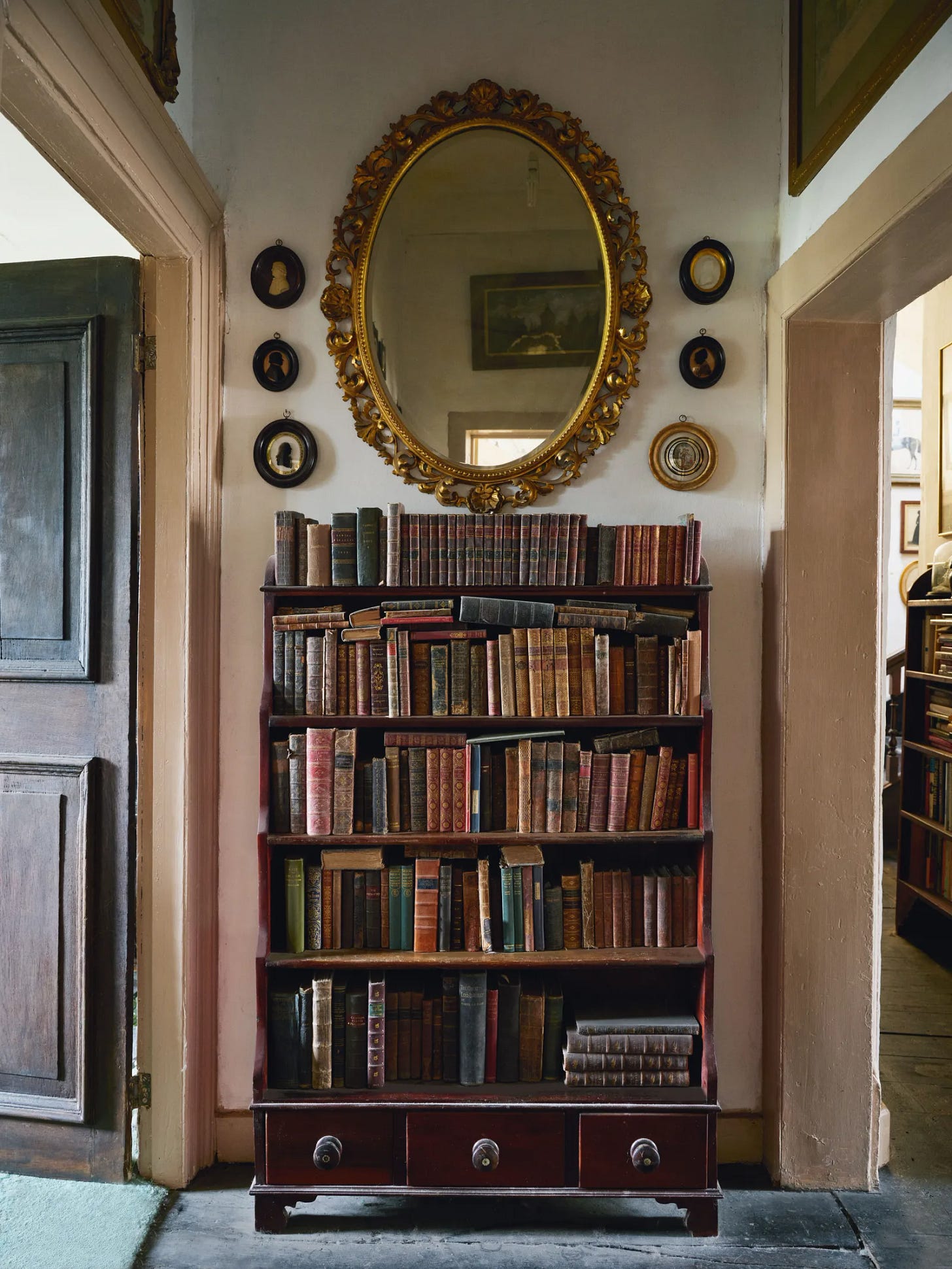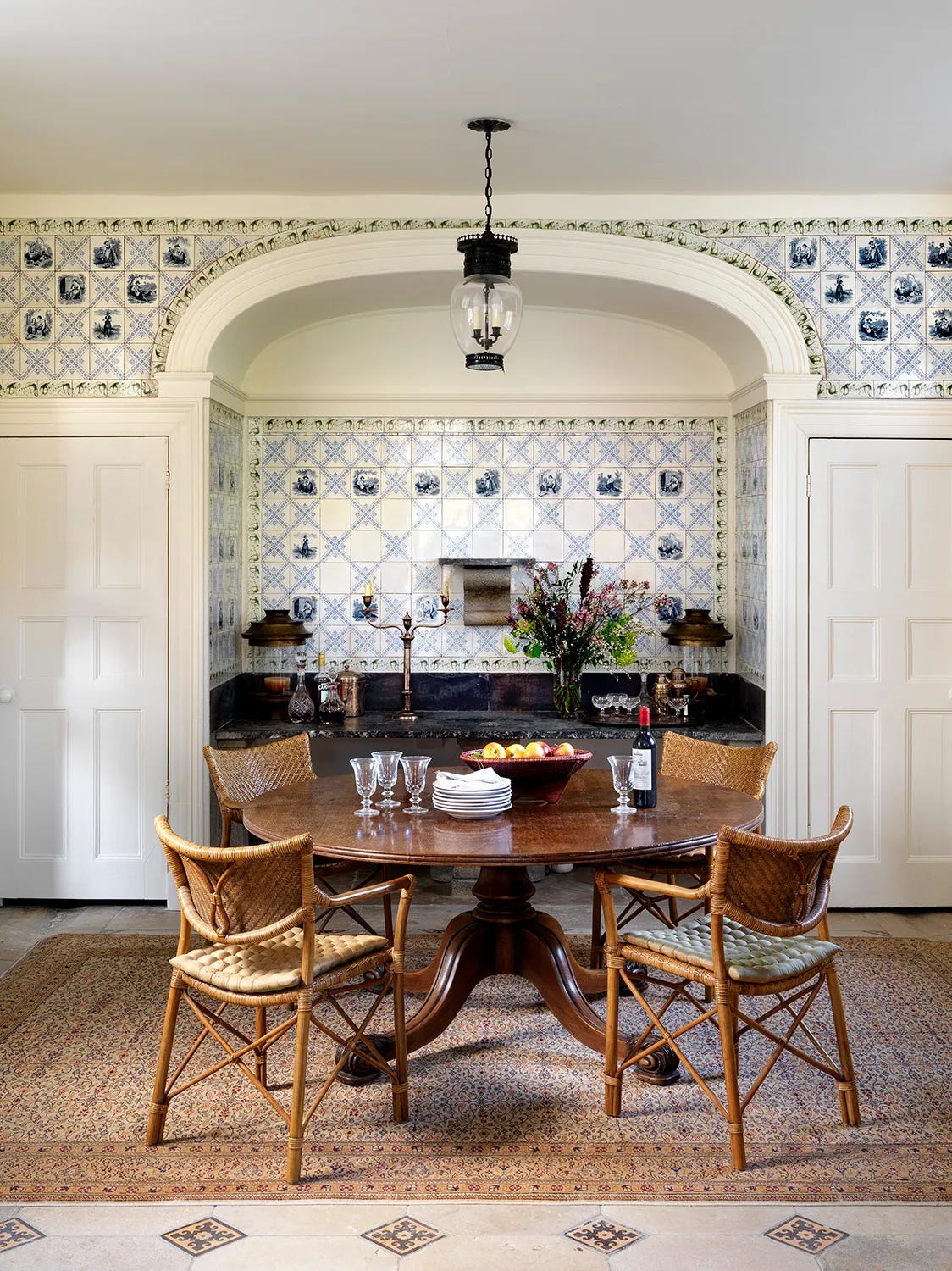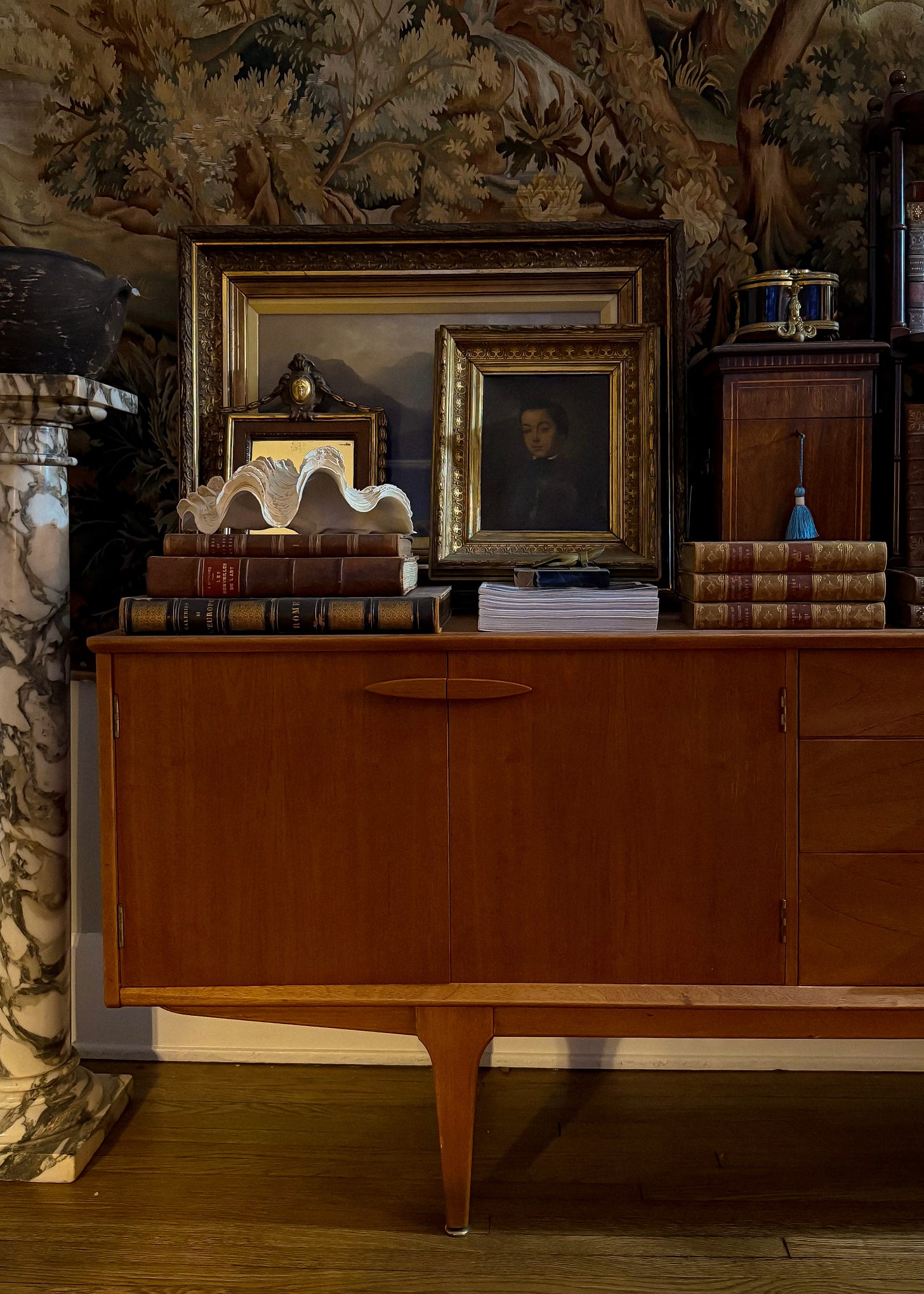Bringing Home the English Look — No Matter Where You Live
You don’t have to live in the English countryside to decorate like you do.
Even before I had a home of my own, I was obsessed with studying interiors. I used to pause period dramas and movies just to snap blurry photos of the rooms on my TV screen — taking mental notes of every stack of leather-bound books, every Regency portrait, and every perfectly historic corner that made those spaces feel like stepping into a fairytale. It was never about the grandeur — although period movies were full of it (I’m looking at you, Pemberley, aka Chatsworth from Pride & Prejudice c. 2005); it was about how those spaces made you feel.
Truth is, I fell in love with English interiors even before I owned a single antique, let alone started collecting and selling them. As I got older, I found myself flipping through the pages of design books, dog-earing every photo where the rooms felt lived-in: stacks of books spilling off chairs, paintings leaned against walls, a cozy chair pulled close to the fire. Nothing matched perfectly in these interiors and that’s what made them magical. These spaces felt sometimes worlds apart from those period drama country homes, yet they held every essence of the historic charm I loved. They felt personal. Soulful. They felt like home, even though they were a world away.
Over time, that love turned into a guiding principle for how I decorate now: not chasing "perfect," but chasing history, charm, and layers. And the best part? You don't need a centuries-old estate to get the look. You just need a little intention, a little patience, and a love for vintage and antiques.
I also think there’s something to be said about appreciating both ends of the spectrum — the grandeur and the everyday — while finding ways to blend the two. A sweeping portrait here, a polished piece of silver there, paired with more humble, worn pieces that bring balance. It's about letting the romanticism of historic design meet the realities of modern life.
So, whether you're dreaming of a countryside manor or working with a cozy rental like me, I hope these timeless ideas can help you bring home the English look, no matter where you live.

Collect Slowly
Homes aren't built in a day. This is a fact I’ve learned to love, despite my control freak impatience. True English interiors often evolve over years, sometimes decades; layered lovingly, not rushed or planned by committee.
Why I love it: When I first started decorating, I thought I had to "finish" my space all at once. That I had to perfectly plant it out. I’d leave doom piles of my latest finds scattered across the house — sometimes not even taking the tags off — waiting for the perfect moment to execute. But over time, I realized the truth: that wasn't building a home, it was building clutter.
Once I let go of the idea of being "done," everything changed. Some of my favorite corners are now the ones that came together slowly — an antique painting found on Facebook Marketplace, a chair picked up from a random thrift shop, a variety of trinkets brought home from our antiquing travels. The slow collecting process lets you grow into your home. It also allows you to experiment. To learn what you love. Don’t overthink it. Don’t expect it to feel perfect. Instead, think of it as every piece carrying a memory or meaning, even if that meaning is just aesthetics. Remember: you’re curating a home you love, one treasure at a time.

Prioritize Comfort
Cozy is the ultimate luxury. English cottages aren’t designed to impress, they’re designed to invite. Overstuffed chairs, warm lamp light, worn rugs, and places to linger.
Why I love it: I want my home to feel like a soft landing. If a room doesn’t make you want to curl up with a book, I’m not interested. The same goes for the furniture. While I love an aesthetic moment for temporary seating (like in an entryway), when it comes to the prime real estate in our living room, I’m judging the couch on how good of a nap I think I’ll have on it. Beauty and function in living room furniture is possible and cottage interiors are a great example of that.

Let the Walls Tell a Story
Use art like wallpaper. Lean framed pieces on shelves, layer paintings over one another, or fill a wall with portraits and landscapes.
Why I love it: Leaning art instead of always hanging them properly instantly changed the whole feeling of my shelves. It made my space feel more collected. It also feels less permanent than hammering something into the wall, and it allows for the kind of experimentation I love. You can swap out art seasonally or as you continue to collect.
Of course, I also love a grand gallery wall, especially the ones you find in old country houses, where heirloom portraits layer from floor to ceiling, each telling its own piece of the family's history. I think that's what draws me in most about English interiors: they remind you that every home, no matter how humble or historic, has the potential to tell a layered, meaningful story.

Mix, Don't Match
Curate, don’t coordinate. Mix styles, eras, and materials. Contrast an ornate mirror with a simple pine bench. Pair a velvet chair with a rustic table.
Why I love it: When everything matches, a room can feel flat, like it was designed all at once and left to sit untouched. But when you mix, the space feels alive. There are no real rules. I love mixing eras, finishes, and styles based purely on instinct and what I’m drawn to. It’s that push and pull and the tension between styles that makes a room interesting. A little bit refined, a little bit rustic. When you trust your eye and layer with what you love, it always somehow works.

Celebrate the Imperfect
Patina is personality. Scratched floors, frayed chair upholstery, a nicked brass doorknob; these signs of life are what give a home it’s soul.
Why I love it: Not everything needs to be shiny and perfect to be beautiful. In fact, it’s often the flaws — the worn edges, the faded spots, the little chips and cracks — that give a piece its real character. Those imperfections create the kind of interest and texture you just can't fake.
There’s a reason so many reproductions try to mimic old patinas, crazing, and craquelure. True age brings a feeling that’s impossible to replicate. Whether they succeed or not is another story… and honestly, I’m a bit of a purist about it. Give me the real thing: flaws, character, history, and all, every time.

Add a Bit of Whimsy
Don't take decorating too seriously. Whether it’s a quirky painting, a hand-painted tile backsplash, or a floral pattern you’d swear your grandmother had —embrace a little unexpected charm.
Why I love it: I’m always the one adding a little “wrong” on purpose when I’m styling. A stack of books or magazines on the floor near the couch. A bust tucked into a corner or on the dining table. Leaving the chandelier lampshades a little crooked like they’ve been dancing. It’s those odd, off beat touches that make a space feel personal and keep it from feeling like a showroom.

Lead with Character
Decorate like it's generational. Even if it’s not. Antiques bring history, texture, and soul to a space, instantly making it feel like it’s been loved for decades.
Why I love it: It’s like flipping on a softer, warmer light. Antiques make a space feel rooted. Think of yourself as the steward of these incredible items; they’re now starting a whole new chapter in your home. That’s personally my favorite part of selling antiques through my shop, Gladys Avenue. Getting to pass these pieces along to someone else who will add to their story feels like a bridge between the past, present, and the future.

No Passport Required
If you’re still with me at this point, here is my biggest take away: Good design isn’t about your square footage or your zip code.
From builder-grade apartments to countryside cottages, the English look is about doing the best with what you have. Layering in history, comfort, and charm, one imperfect, beautiful piece at a time. It’s not about the blueprint. It’s about how you layer meaning into your space and how you choose to surround yourself with pieces that make you feel something.
I think about this a lot when I look around our little duplex in northeast Ohio. It’s not a sprawling estate. It’s not dripping in architectural details. There’s so much that I can’t change. But through vintage finds, layered textiles, old paintings, and pieces that hold meaning, it’s become a place that feels warm, personal, and full of life (and past lives).
So, here’s to creating homes that feel lived-in, loved, and entirely your own.
Happy decorating!
xx, Veronica






